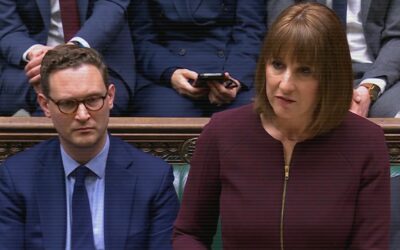Following our recent article on customer service, the other side of the coin in terms of HMRC effectiveness relates to its compliance activity.
- Current Tax Gap is 4.8%, or £36bn for 2021/22
- HMRC neither resourced nor tasked to reduce the Tax Gap below its current level
- £1 invested in tax compliance produces on average £14 additional tax revenue
- Poor handling of compliance cases affecting business performance
Tax Gap
The Tax Gap is broadly defined as the difference between the tax which should be paid under the current tax legislation in force and the amount that is actually paid for a given year. The higher the Tax Gap estimate, the more revenue that has not been successfully collected in a given year. Since first publishing a comprehensive analysis of the Tax Gap back in 2005-06, the overall trend has shown the gap being reduced proportionately through to 2020-21, since when it has held flat at 4.8%.
Some elements of the tax gap calculation are inherently more uncertain and are subsequently revised based on newer data. One dramatic example of this is the estimated levels of fraud and error in research and development (R&D) tax reliefs for small and medium sized enterprises (SMEs) which reached 24.4%1https://www.gov.uk/government/publications/compliance-approach-to-research-and-development-tax-reliefs/hmrcs-approach-to-research-and-development-tax-reliefs dated 17 July 23. These were published after the latest tax gap estimates in June 2023 and increased the estimate of error and fraud for 2020-21 from £336m to £1.13bn. While this has a small impact on the overall tax gap, these additional amounts increased the corporation tax gap for those customer groups in that year by two percentage points from 21.2% to 23.3%.
Another issue about the tax gap involves what is – and isn’t – included within the figures. For example, offshore profit-shifting activities by multinational corporates are generally excluded, unless covered by specific current UK legislation, because these additional amounts are more akin to a ‘policy gap’ that can only be corrected by changes to legislation2https://committees.parliament.uk/oralevidence/978/default/ Q31.
Another area that is also currently omitted from the Tax Gap estimate relates to the amount lost due to assets held offshore by UK taxpayers. The then Financial Secretary to the Treasury, Lucy Frazer, announced in May 20223https://www.ft.com/content/00e7a52d-d85e-467c-b287-5d592b37035c and https://www.ifcreview.com/articles/2023/january/boots-on-the-ground-why-the-uk-taxman-is-unable-to-estimate-the-offshore-tax-gap/ that HMRC would publish a standalone ‘offshore tax gap’ during 2023, and this commitment was re-iterated by HMRC in June 20234https://www.gov.uk/government/statistics/measuring-tax-gaps/methodological-annex#chapter-a-introduction A19. However, this publication is yet to be released at the time of writing. Given that overseas banks are now required to report data to HMRC about assets held by UK taxpayers via the Common Reporting Standard (CRS), it is a concern that HMRC still does not appear to have been able to arrive at a level of non-compliance. From nudge letters about offshore assets in the year ended March 2022, just under £300m in additional tax was recovered5https://www.ifcreview.com/articles/2023/january/boots-on-the-ground-why-the-uk-taxman-is-unable-to-estimate-the-offshore-tax-gap/. Despite many years of offshore disclosure opportunities, this suggests there are still plenty of people who are not compliant. TaxWatch calls on HMRC to attempt to provide this additional data for inclusion in Tax Gap calculations.
Tackling the tax gap
HMRC uses a wide range of methods to tackle non-compliance across all customer types and taxes. Published tax gap data are the amounts believed to be outstanding after sums recovered due to this compliance activity, meaning that additional work in those areas would result in a reduction in the tax gap. When the National Audit Office (NAO) looked at HMRC’s compliance work, it found HMRC had changed the methodology used to smooth out the tax gap figures between years, observing that ‘although compliance yield reduced during the pandemic, this has not resulted in an increased tax gap estimate. HMRC’s latest estimates suggest compliance yield reduced by 0.8% of total tax revenue in 2020-21 but the tax gap remained stable…’ . The main finding from the NAO report was that HMRC raised £9bn less in compliance yield across the two pandemic years compared with the historical average.
HMRC appears to be generally tasked with keeping the tax gap at a stable percentage of the total theoretical tax due6https://assets.publishing.service.gov.uk/government/uploads/system/uploads/attachment_data/file/1179615/HMRC_annual_report_and_accounts_2022_to_2023.pdf P17. In its Annual Report it says: ‘We set our targets for compliance yield at a level intended to keep the tax gap stable and deliver additional revenues from recent investments in our compliance work.’ This means that the absolute amounts lost go up as the tax due increases because of inflation and changes in the tax base. The tax gap for 2021-22 has been estimated at £35.8bn, 4.8% of total tax liabilities7https://www.gov.uk/government/statistics/measuring-tax-gaps/1-tax-gaps-summary, and is likely to reach £40bn in 2022/23.
HMRC’s approach to tax compliance work
HMRC breaks compliance activity into two main types:
Upstream compliance is activity intended to encourage voluntary compliance and prevent non-compliance before it happens. This includes a range of approaches such as changing legislation to close loopholes, changing processes to reduce opportunities for avoidance or evasion and education and prompting to ensure taxpayers get things right first time.
However, one step before this is a requirement for suitable systems which make it as easy as possible for people to get things right. It includes simple working online services, clear guidance and access to appropriate support. From our previous article about telephone services it is clear that continued failings in this area could potentially cause an increase in non-compliance due to the difficulty for taxpayers to get access to the right advice. Additional numbers of taxpayers and the increasing complexity of affairs previously discussed mean that there is a real risk to the numbers of taxpayers that get their affairs right first time.
Downstream compliance is activity to identify and tackle non-compliance after it has occurred. This is what is generally considered to be more traditional work to monitor and identify risks, prompt taxpayers to correct where potential failings are identified, carry out investigations and pursue the correct amounts of tax to be paid, alongside interest and penalties where appropriate. This can also include taking cases to tribunals or civil or criminal courts.
Some of this work can be at the most complex and challenging end of work within HMRC and requires an experienced and well-trained workforce. As we will discuss in a later article, long-term workforce planning is a must for ensuring that this work can be carried out efficiently and successfully.
Return on investment in compliance
There are difficulties in arriving at reliable figures for the return on investment in compliance activity due to the fact that yield from compliance recorded in any year will usually involve cases where additional tax is due for a number of previous years. Enquiry cases, particularly large or complex ones, can take some years to resolve so it is hard to exactly match the cost of those cases to the yield produced. However, HMRC produces data comparing compliance costs in a year with the compliance yield generated. These figures indicate that there are strong positive returns from such investment in relation to all taxpayer groups (what HMRC calls “customer groups”).
Return on investment in compliance by customer group
Investment return for every £1 spent, in pounds
| 2019-20 | 2020-21 | 2021-22 | 2022-23 | |
| Individuals | 7.8 | 6.3 | 6.6 | 7.4 |
| Wealthy individuals | 11.6 | 15.8 | 11.4 | 12.5 |
| Small businesses | 15.2 | 11 | 13.8 | 10 |
| Mid-sized businesses | 18.5 | 11.9 | 13 | 14.6 |
| Large businesses | 75.2 | 60 | 39.2 | 36.4 |
| Total | 21.8 | 17.4 | 15.5 | 14.3 |
The NAO has recommended that HMRC should better evaluate its different types of compliance activities, to enable allocation of resources based on risk, and to look at the impact on taxpayer behaviour of changes in compliance activity, which would better support the workforce planning required for optimal returns on investment8https://www.gov.uk/government/statistics/measuring-tax-gaps/1-tax-gaps-summary.
HMRC missed its internal targeted compliance yield in 2022-23 by £2bn (against a target of £36bn), ascribing some of this as over-hangs from the Covid-19 pandemic.
However, additional investment to reduce the tax gap is generally only made as one-off funding pots announced in budgets to deal with particular compliance issues. The most recent of these was announced in the Autumn Statement of 2022: £79m across five years to tackle serious cases of tax fraud and non-compliance amongst wealthy taxpayers. This was forecast to bring in an additional £725m in tax revenues – clearly a huge return on that investment and tracking its impact will be crucial to judge whether the expected revenues have materialised. However, £79m is a tiny sum in comparison with total compliance spending and, given that suitably trained staff cannot normally be recruited for short-term periods, they require redeployment from other areas.
When compliance goes awry
An example of why proper workforce planning and investment in training of tax professionals is required comes from issues which have arisen in relation to R&D tax relief. As mentioned above, recent data arising out of a random enquiry programme has provided evidence to HMRC of problems that have been widely discussed for a number of years in relation to this relief. The relief enabled SMEs to obtain partial refunds of their expenditure on qualifying research and development. The scope of the relief, being non-sector specific, resulted in a whole industry of ‘specialist’ advisers springing up to exploit the scheme via cold-calling large numbers of businesses and persuading them that they were eligible for cash back from the government for expenditure that clearly doesn’t qualify. The result was the overall cost of the scheme rocketing to £7.6bn in 2021-229https://www.gov.uk/government/statistics/measuring-tax-gaps/1-tax-gaps-summary and forecasted to reach £9.5bn by 2027-2810 … Continue reading. When the relief was first introduced it was forecast to cost only around £1bn in 2017-18, but the actual cost in that year was £2.2bn, already more than double.
In the last few years there has been a rush by HMRC and the Treasury to try to deal with the R&D relief problem through repeated changes to legislation, reducing the benefits and increasing the administrative requirements, in order to make them less attractive and less easy to exploit. However, recent recognition of large amounts of fraud and error, particularly amongst SMEs, has resulted in a ratcheting up of compliance activity in an attempt to recover some of the lost amounts. In the past there was a specialist unit in HMRC dealing with R&D reliefs, partly because it is a specialist area with qualification requirements that don’t fit with other tax legislation. That unit has disappeared and compliance requirements now appear to be handled by bulk compliance teams where no single officer takes responsibility for an enquiry, and stock letters and responses are being issued which don’t take into account information previously provided. In addition, advisers report that it is impossible to speak to anybody dealing with an enquiry, meetings are being refused and cases are being handled inconsistently and not in line with HMRC guidance11 … Continue reading. The situation has become so difficult that it’s been reported that some companies are withdrawing what they believe are legitimate claims because the compliance burden is just too high12 … Continue reading. At an extreme, we are aware of at least one company that has moved its entire R&D function out of the UK during an enquiry because it felt it was not being treated appropriately by HMRC13https://www.linkedin.com/pulse/fintech-disruptor-moves-rd-offshore-over-tax-credit-enquiry-meakin/?trk=article-ssr-frontend-pulse_little-text-block.
This demonstrates how a lack of timely and appropriate investment in HMRC compliance is actually working against initiatives to encourage investment activity and potentially even driving business and innovation out of the country.
The problem with tax advice
Another area where HMRC has been slow to make progress is in dealing with the source of many compliance problems, ie. advisers and other ‘professionals’ who offer services designed to exploit taxpayers and/or HMRC. Over many years there have been gradual changes to legislation and processes which have resulted in significant reductions in most types of avoidance schemes and, more recently, have prevented direct access to taxpayer client repayments. But there are still large numbers of promoters said to be involved in disguised remuneration schemes and ongoing issues arising from advisers encouraging businesses to wrongly claim R&D tax relief.
In addition, there are plenty of legacy cases where individuals have ended up with significant tax bills, such as those affected by the loan charge. This is after following, at best, misleading advice peddled by advisers who have usually walked away after pocketing substantial fees. HMRC has not taken timely action against them – in some cases, it is clear that HMRC did not or do not have effective powers to do so but in addition, pursuing such cases is difficult.
HMRC has run a number of consultations over the last few years looking at the best way to raise standards in the tax advice market. It is surprising to many taxpayers when they discover that the tax advice market, unlike most financial services, is not regulated in any way. Anybody can provide tax advice without holding any qualifications. While there is an argument that this is not just HMRC’s responsibility, it has a direct impact on its function and customers. It is therefore disappointing that the last episode of consultations in this area was solely focused on the potential for advisers to be required to have public indemnity insurance with the conclusion that this was not the answer. The report, published in November 2021, stated that there would be a further consultation in 2022, but that has not materialised, so progress towards a solution is no further advanced. TaxWatch is currently compiling a report on the potential options for some form of regulation of the tax advice market but we would also like to see a commitment from HMRC to actively work on this issue.
An area where HMRC is regularly criticised is for its failure to use criminal powers to deal with the most serious cases of non-compliance. The number of criminal investigations conducted by HMRC which resulted in prosecution has fallen significantly since the mid-2010s, though this is part of deliberate action by HMRC to focus on a smaller number of high-value or serious cases. HMRC has always had a discretionary prosecution policy with its main aim to be to collect amounts due in the most efficient way possible. 240 cases went to court in 2022/23 with a 91% success rate. However, in the five years to March 2022 there were only 66 prosecutions of professional enablers of evasion, with only eight of those in the latter two years. This is concerning given the ongoing problems within the adviser market. Recent evidence shows a lack of appetite for using very specific criminal powers brought in to tackle areas of concern, such as the corporate criminal offence for companies that facilitate tax evasion. While HMRC reports investigations, no cases have yet been prosecuted despite the offence’s introduction in 2017. As Dan Neidle says: ‘A law that is not publicly enforced may as well not exist’ 14https://www.theguardian.com/business/2024/jan/20/a-tax-evasion-law-not-publicly-enforced-may-as-well-not-exist.
While it is hard to measure the deterrent effect of prosecution, there is a risk that reducing activity in this area creates the impression that fraudulent behaviour is worth the risk, given that the chances of being prosecuted are so low.
Conclusion
The tax gap is a measure of additional amounts of tax that should be collected if everybody paid the amount they should under current laws. Subject to the difficulties in calculating this, it would seem a reasonable aim that any tax authority should try to reduce this to its lowest practical minimum, and particularly at any point where the return from investing in compliance activity is positive.
There are still some fundamental issues around the subject of compliance for HMRC. It needs to resolve issues around the tax advice market, it needs a proper workforce plan with trained and motivated staff able to deal with all aspects of compliance and it needs to consider and evaluate new ways of ensuring and monitoring the effectiveness of compliance work as the world evolves. As we have previously pointed out, it also needs a support service for customers that makes it as easy as possible to get things right.
All of this will require funding to put the backbone in place, but the return on this investment in terms of a more trusting taxpayer population, increased voluntary compliance and compliance yield should be more than worth that investment.
References



